A tube and coupler scaffolding is a framework supported by tubes and is erected through coupling devices that connect braces, bearers, runners, and uprights. This structure is built from tubing connected by coupling devices and is widely recognized as a versatile type of scaffold consisting of steel or aluminium tubes and clamps, which allows connecting steel pipe and couplers at any interval to meet unique project needs. This scaffold can bear heavy loads due to its exceptional strength. It supports multiple platforms to reach several stories of buildings. Tube and coupler scaffolds can be assembled in varied directions; they are the best temporary structures for projects with irregular shapes, contours, or dimensions.
The main benefits of tube and coupler scaffolding are safe load capacity, a wide range of applications, cost-effectiveness, and adaptability. The main parts of tube and coupler scaffolding are standards, ledgers, couplers, volts, guardboards, and planks. The main uses of tube and coupler scaffolding are repair and maintenance, window cleaning, building construction, painting, and decoration.
Table of Contents
What is Tube and Coupler Scaffolding?
Tube and coupler scaffolding is a temporary structure created by connecting steel tubes with an adjustable structure. Tubes and couplers are used to form a highly customizable structure. You can adjust this project’s height, configuration, and shape to meet the specifications of complex projects, unique geometrics, and extraordinary architectural designs.
You can adapt the tube and coupler scaffold configuration to meet the needs of varied heights, widths, and loads. Tube and coupler scaffoldings are commonly used in commercial and industrial settings because design versatility, durability, and precision are most needed. High-quality materials are used to create tube and coupler scaffolds to create a temporary structure that supports heavy loads and offers exceptional stability.
Tube and Coupler Scaffolding Images


What are the Benefits of Tube and Coupler Scaffolding?
The six benefits of tube and coupler scaffolding are as follows:
- Adaptability
- Safe Load Capacity
- Wide Range of Applications
- Easy to Assemble and Disassemble
- Cost-Effective
- Convenient Storage and Transport
1. Adaptability
The biggest benefit of tube and coupler scaffolding is its modular nature, which makes it super adaptable. Whether a project is simple or complex, you can configure tubes and coupling devices to create a custom temporary platform.
2. Safe Load Capacity
Another plus point of tube and coupler scaffolding is its safe load capacity. This structure is made of high-quality, strong materials, which add to its strength. Regardless of how demanding a construction task or maintenance project is, workers can handle it well through this scaffold, which offers safety and stability side by side.
3. Wide Range of Applications
Tube and coupling scaffolds are versatile, which means they have numerous applications in different industries. You can use them during building construction, maintenance work, renovation tasks, and other similar tasks. They offer safe access and stable support to workers who can handle various tasks with ease.
4. Easy to Assemble and Disassemble
Tube and coupler scaffolding has a modular design where labor can put together tubes with coupling devices in less time and without much effort. Its quick assembly and disassembly reduce time and save labor costs while increasing productivity at the work site.
5. Cost-Effective
Tube and coupler scaffolding can be reused again and again as tubes and coupling devices are made of long-lasting materials. As a result, investing in this kind of temporary structure lets you reap benefits for years. The system is highly durable and has a long lifespan, both aspects contributing to its cost-effectiveness. Besides, it requires minimal maintenance over time, so you don’t have to spend a lot on its upkeep.
6. Convenient Storage and Transport
Another benefit of tube and coupler scaffolding is its modular components, such as coupling devices and tubes, take less space. You can store them in a limited space. When it comes to transportation of these components, you can easily manage logistics due to the compact nature of components with manageable weight.
What are the disadvantages of Tube and Coupler Scaffolding?
The seven disadvantages of tube and coupler scaffolding are as follows:
- Complex Assembly
- Requires Skilled Labor
- Time-Consuming
- Higher Risk of Errors
- Costly for Small Projects
- Heavy Weight
- Storage Issues
1. Complex Assembly
The biggest issue with tube and coupler scaffolding is its complex assembly. There are so many tubes and coupling devices that laborers need to put together carefully. It doesn’t have pre-fabricated components, so individual tubes and couplers must be joined manually. Assembly requires precise measurement and alignment of tubes. If your project has a limited timeline, it’s better to seek an alternative scaffolding with quick assembly.
2. Requires Skilled Labor
Another drawback of tube and coupler scaffolding is that it requires skilled labor who can assemble its complete framework. Hiring less skilled workers means mistakes and errors in the scaffolding, which leads to accidents and project delays. A lack of expertise is an apparent safety hazard you must avoid. Hiring skilled labor means increasing overall project costs.
3. Time-Consuming
Another disadvantage of tube and coupler scaffolding is that it comprises a huge number of components, so its assembly is time-intensive. It is not a suitable temporary structure for projects with tight deadlines.
4. Higher Risk of Errors
There are so many components that workers need to put together. This specific system has a high risk of errors as assembly depends more on human judgment. There is a high risk of accidents for the workers if any connection is loose or the structure is not properly aligned. Only trained and skilled staff should be hired for its assembly to prevent minor mistakes that lead to detrimental accidents or delays.
5. Costly for Small Projects
Tube and coupler scaffolding is unsuitable for small-scale projects because initial investment in this specific type of scaffolding is high. If a project is low-budget or short-term, the overall cost will be higher than its benefits. Small contractors should look for other economical options
6. Heavy Weight
Another drawback of steel tubes and couplers is that they are very heavy. For transportation and regular handling, you will need more workers to carry and assemble all the components. Moving this type of scaffolding in remote and constrained areas will be difficult.
7 . Storage Issues
Another major issue with tube and coupler scaffolding is that it comprises numerous components. It’s always a challenge to store so many elements. Once dismantling this system, you must ensure that all the required components are stored securely. If you don’t remain careful, component loss or damage leads to replacement expenses. If a project has limited storage facilities, it’s normal to encounter logistic challenges that would increase the overall project cost.
What are the uses of Tube and Coupler Scaffolding?
The seven uses of tube and coupler scaffolding are as follows:
- Building Construction
- Repair and Maintenance
- Painting and Decorating
- Window Cleaning
- Demolition Support
- Tight or Narrow Spaces
- High-Rise Buildings
1. Building Construction

Tube and coupler scaffolding is primarily used for connecting residential, industrial, and commercial buildings. This temporary structure is highly flexible and can be adapted to different shapes and sizes. Whether you need to construct a complex site or a building with an irregular design, tube and coupler scaffolding would prove effective. It offers a safe platform where workers can access elevated areas.
2. Repair and Maintenance

Another everyday use of tube and coupler scaffolding is in repair and maintenance tasks. For example, it allows workers to reach varied heights and perform roof repair and other maintenance tasks with ease. This temporary structure provides safe access to otherwise hard-to-reach areas.
3. Painting and Decorating

Tube and coupler scaffolding provide a platform for painters who can stand on it and perform painting tasks with precision and ease. Whether paintwork needs to be done inside or outside, this one temporary structure will be good enough for both the exterior and interior. It offers a stable platform where decorators can put their materials and keep doing their decoration tasks without worrying about any risk. Whether painters or decorators need to complete their tasks around oddly shaped domes, facades, or complex structures, tube and coupler scaffolding proves effective as it can be adjusted as per project requirements.
4. Window Cleaning

Tube and coupler scaffolding offers a sturdy framework that window cleaners can use. This temporary structure allows workers to operate at varied heights. They can create a secure workspace for projects that require vertical access, especially window cleaning on tall buildings.
5. Demolition Support

Tube and coupler scaffolding is used as a demolition support. Basically, this temporary structure has high load-bearing capacity and exceptional strength. It provides support to a structure that needs to be taken down. It also used to hold a debris containment system during the demolition process. This stable structure ensures safety during the risky demotion operation.
6. Tight or Narrow Spaces

Tube and coupler scaffolding can fit in narrow and tight spaces, such as narrow building gaps, underground tunnels, and alleyways. You can customize its structure according to the project specification without compromising structural stability.
7. High-Rise Buildings

The best thing about tube and coupler scaffolding is that it can be raised to virtually any height. Thereby, you can use this sturdy structure for high-rise building construction. You can work on high-rise projects with convenience through this kind of scaffolding.
What are the parts of Tube and Coupler Scaffolding?
The eight parts of tube and coupler scaffolding are as follows:
- Standards
- Ledgers
- Braces
- Putlogs
- Planks/Boarding
- Rails/Guard Boards
- Volts
- Couplers
1.Standards
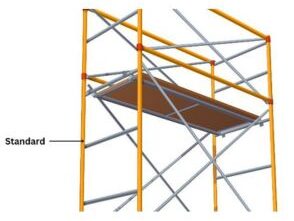
Standards are vertical tubes installed in the tube and coupler scaffolds. These vertical tubes transfer the load of the temporary structure evenly to the ground and are installed at regular intervals and connected by ledgers to create a load-bearing framework. They act as a backbone of the overall tube and coupler system.
2.Ledgers
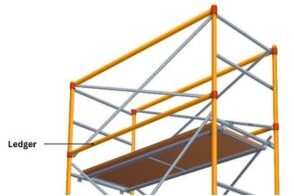
Ledgers are horizontal tubes that connect with the standards and render lateral support to the overall structure. Their role in tube and coupler scaffolding is to serve as a framework that provides support to the working platform. They are installed in the structure at the correct spacing to ensure the overall stability of the tube and coupler system. Depending on the required scaffold levels, ledgers are placed at varied heights.
3.Braces
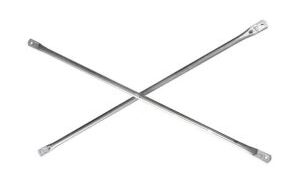
Braces are diagonal tubes that enhance rigidity of the structure, especially when a temporary structure needs to be developed for a more complex and taller work site.The best thing about braces is that they prevent structure from deformation and swaying under heavy wind pressure or load scenarios. Braces create a triangular support system to provide additional stability features to tube and coupler scaffold.
4.Putlogs

Putlogs are the horizontal tubes that are fitted with flat ends to connect the tube and coupler scaffold with the supporting wall or building. The one end of horizontal tubes rest on supporting structure and another end on the scaffold framework. It works as anchors for the framework and enhances overall stability of the scaffold.
5. Planks/Boarding

Planks or boarding are metal or wooden boards that serve as the working platform in tube and coupler scaffolding. These platforms serve as a surface where workers can stand and keep their tools and materials while moving across project site. Planks are secured to prevent slipping and they are strong enough to bear the weight of workers, materials, and tools.
6. Rails/Guard Boards
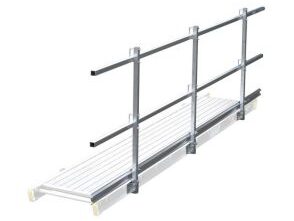
Rails and guardboards are placed along the platform’s edge at varied height levels. These rails work as a safety barrier that offers protection to workers and prevents them from falling off the scaffold. Rails and guardboards are essential safety features that must be installed on tube and coupler scaffolding to stay compliant with industry safety regulations.
7. Volts
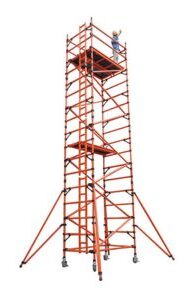
Volts are an integral part of tube and coupler scaffolding. They are used to secure scaffolds in a specific way, secure a working platform so that workers have a stable surface to use, and provide additional connection points for unique scaffold setups. Depending on the scaffold design or requirement, the uses of volts vary.
8. Couplers
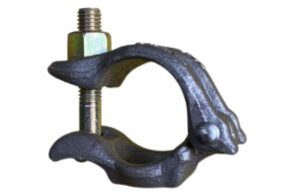
Couplers are the fittings used to join tubes at various angles and keep all the connections secure throughout the tube and coupler scaffolding. Coupling devices are crucial in this scaffold as they make it possible to create custom configurations. They allow flexible connections based on the contour and configuration of complex projects. There are different types of couplers, such as right-angle couplers, swivel couplers, and sleeve couplers. Right-angle couplers connect tubes at a 90-degree angle, swivel couplers connect tubes at adjustable angles, and sleeve couplers connect two tubes end to end.
What is the Diagram of Tube and Coupler Scaffolding?







